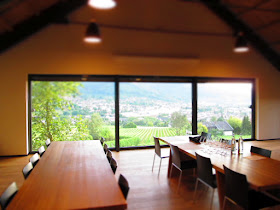As I am just as hip as all the hipster wine writers out there, I also believe I am sick of the tasting note as well. I absolutely detest writing them so I am just going to write about this latest trip and focus on what was memorable in a slightly stream of conscious style, which ultimately, I think will give readers a better feel for the experience and will be a hell of a lot more enjoyable for me to write and you to read.
Usually I get off the plane and we drive straight to the Mosel, but this year, we were off to Iphofen, and then to Burgstadt, where the great Rudolf Furst winery is, which has become an annual pilgrimage for me. It's not a complete year unless I visit Sebastien Furst at his winery. I see Paul, his father, only briefly, but I always see him. We got right to it as we taste from barrel first and then hit the latest vintages in bottle in the glorious new tasting room.
 |
| The new tasting room with a killer view of the Centgrafenberg |
The 2011's out of barrel were wonderful and I must say Sebastien is getting better and better as a winemaker every year. There is a definite hierarchy developing among the Pinots. Hunsruck is the bad dawg in the stable. Meaty, rich, with a major structure and layered like only the best can be. But it is also a serene wine. There is also a unique earthy mineral element due to the limestone/sandstone soils. The Schlossberg is the La Tache with its intense and pure fruit energy. I always get a lot of spice out of the Schlossberg. The Centgrafenberg is extremely aristocratic with stunning aromas, but is always, to me at least, tremendously structured. The '11 Hunsruck was not showing much out of barrel and was all out of sorts. But when we tasted the 2010 later, it revealed its pure bad-assness. The 2011's have a fleshy, ripe vibe to them and are lower acid than the freakish 2010's. They are kind of like 2007 I'd say. Kingenberger is like the over-performing 1er Cru. Always drinks so well. Never had a closed one. It gains more depth each year it seems. The spicy mineral complexity is particularly fine in the 2010. The 2010 Tradition, which is the village wine, is such a great value and competes with Burgundy on a pure QPR basis every year. 2010 had the highest acid levels in 10 years.
 |
| Tweeting and Facebooking with the Centrgrafenberg behind me |
And then there are the Fruhburgunders. In the hands of Sebastien Furst this grape can get no higher. Pinot Madeline in France and Ruby Cabernet in California, this early ripening Pinot Noir in its teutonic iteration slays me. Especially at Chez Furst. The 2010's are the best I have ever tasted and that is after many great bottles of Fruhburgunder at this estate. The normal cuvee is just called Fruhburgunder Centrgrafenberg and has serious aromas going on. Pure violets and candied minerality. Just wafting. The type of wine that you can stand on a chair and hold the glass by your waist and still smell it as if your nose is in the glass. Layers of sweet, ripe concentrated fruit and that tiny berry intensity explodes in your mouth. Succulent and massive. The R, which is the "GG," but there is no GG for Fruhburgunder, so its labeled as R, which is what they labeled their wines here before the GG's started. This is just an absurdly concentrated wine with amazing purity and a formidable structure.
 |
| The Centgrafenberg |
The whites are so underrated here, but that is the fault of Sebastien, whose reds are just so damn good. The 2011 Muller Thurgau is the best in years. Like the 2007 or 2005. Elegant and just floats on the palate. Redefines what Muller Thurgau can be. The Silvaner Centgrafenberg is elegant as well with a lacey-like mouthfeel. Acck! I am writing tasting notes. Must resist. Anyway the Rieslings here are mineral, mineral and more mineral. High acids as well. I love them, but these Rieslings need age because they are SO much better with 5-6 years in the bottle. A 2005 Riesling Centgrafenberg this summer blew my mind and in its youth the wine was very mineral and acidic.
The 2011 whites will be somewhat accessible, but drink the Silvaner and Muller Thurgau, while you wait on the Rieslings and Spatburgunders.
That night we went to dinner and Sebastien brought a 1990 Spatburgunder Spatlese, which nowadays is the same as the Spatburgunder Tradition. It was lovely. Smokey, meaty and mineral with excellent acids and foiled short rib perfectly.
A great visit and everybody should do their best to get the profound 2010 Spat and Fruhburgunders from the Rudolf Furst Estate. Until next year, Burgstadt.





No comments:
Post a Comment